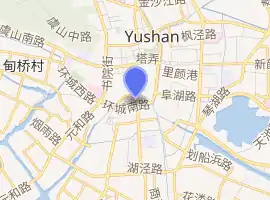Former Residence of the Weng Clan
The Former Residence of the Weng Clan (Chinese: 常熟翁氏故居; pinyin: Chángshú Wēngshì Gùjū, also called Former Residence of Weng Xincun) is located on the Weng Lane, Changshu, Jiangsu Province, China. It is a typical example of the gentry maisons in the regions south of the Yangtze River. The house was listed as a municipal cultural relics protection unit in 1982 with the name "the Former Residence of Wen Xincun". Its main hall, called "Caiyi Hall" (彩衣堂), was listed into the fourth group of National Key Cultural Relics Protection Units in 2001 and is now open to the public as the Memorial of Weng Tonghe.
| Former Residence of the Weng Clan | |
|---|---|
翁心存故居 | |

| |
| General information | |
| Address | No. 2, Weng Lane |
| Town or city | Changshu, Jiangsu Province |
| Country | China |
| Coordinates | 31.64048°N 120.74165°E |
Original building
The residence dates from the Ming dynasty and originally belonged to the Sang Clan. It became Yan Cheng's property during the Longqing era (1567–1572) and underwent several changes of ownership afterwards. In the 13th year of the Daoguang era (1833) of the Qing dynasty, Weng Xincun (翁心存)[1] bought the mansion from the Zhong family, and his son Weng Tonghe grew up here. It occupies a total area of 6,000 m², and the gross building area is about 3,000 m².
Caiyi Hall
| Caiyi Hall | |
|---|---|
彩衣堂 | |

| |
| General information | |
| Address | No. 2, Weng Lane |
| Town or city | Changshu, Jiangsu Province |
| Country | China |
| Coordinates | 31.64048°N 120.74165°E |
Built in the late Ming dynasty and occupying an area of 235 m², the Caiyi Hall[2] is the third hall along the central axis of the whole residence. Serving as the main hall, it was first called "Sengui" (森桂) and was renamed as "Conggui" (丛桂)[3][4] " afterwards. When Weng Xincun rebuilt it, he changed its name to "Caiyi Hall". This name is taken from the story of Old Laizi[5] and it carries the meaning that children should try to make their parents laugh by any means possible. The hall is 3 bays[6] wide and features a "yingshan" (firm-mountain-sloped) roof (硬山顶)[7] with nine rafters and "five purlins cross-beam".[8] On either side of the hall stands a room and a roofed walkway connects it with other halls at its back. The traditional decorative colorings painted on the pillars are of high artistic value and they are considered masterpieces of the Suzhou style decorative paintings (苏式彩绘).[9]
References
- 知止齋詩集, 第 1519 卷 續修四庫全書: 集部別集類 知止齋詩集, 翁心存 (in Chinese). ISBN 9787532524600.
- 江南綵衣堂/翁同龢家族文化史/中国近现代文化世家书系: 翁同龢家族文化史 (in Chinese).
- "Conggui" (丛桂) is originated from a line in a Song dynasty poem.全宋詩, 第 29 卷 全宋詩, 傅璇琮 (in Chinese). 北京大學出版社. 1998.
- Weiquan, Zhou (2008). 中国古典园林史 周维权. 清华大学出版社. p. 792.
- Old Laizi (中文:老莱子) is one of the Twenty-four Filial Exemplars (二十四孝)
- Here, bay (structure) is the zone between the outer edges of an engaged column.
- "yingshan" (firm-mountain-sloped) roof is one style of the double-sloped roof in traditional Chinese architecture. See also Wenming, Bai (1999). 中国古建筑艺术 第3册 构件·单体 (The Art of ancient Chinese architecture, installment 3, structural member·single structural member). 黄河出版社. ISBN 7-5329-1338-4.
- In traditional Chinese architecture, the beam can be named according to the number of purlins that it supports. Here, the beam support five purlins and thus called "five purlins cross-beam" (中文:五架梁). More information about this architectural term, please see Bailu, Shen (2006). 建筑装饰设计 (Architectural Ornament and Design). 机械工业出版社 (China Machine Press). p. 320. ISBN 7-111-17316-3.
- Typical examples of the Suzhou style decorative paintings (苏氏彩绘).Shixiang(王世襄), Wang. 清代匠作则例,卷一,内庭圆明园内工诸作现行则例· 画作定例. pp. 245–263.
Further reading
- "常熟彩衣堂 尚书故居亲民本色". Archived from the original on 2016-03-03. Retrieved 2012-04-30.
- The Art of Decorative Paintings in Caiyi Hall (彩衣堂建筑彩画艺术). 上海科学技术出版社. 2007. ISBN 978-7-5323-8951-3.